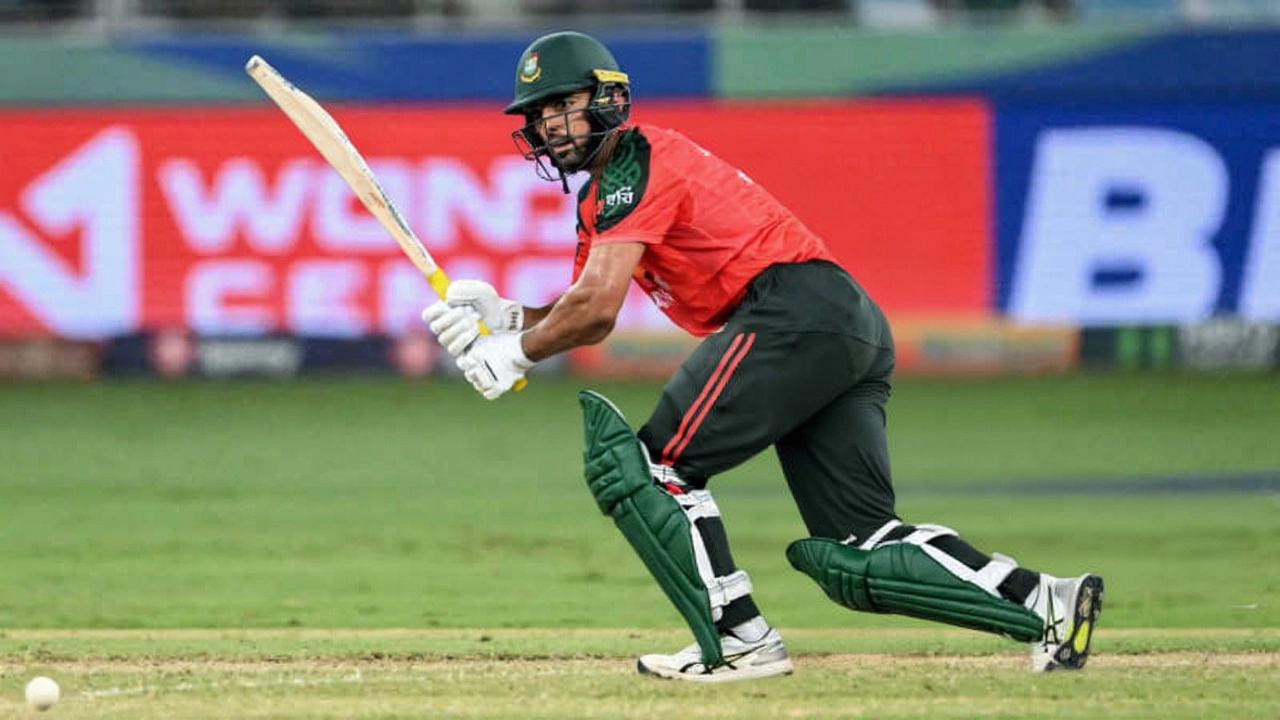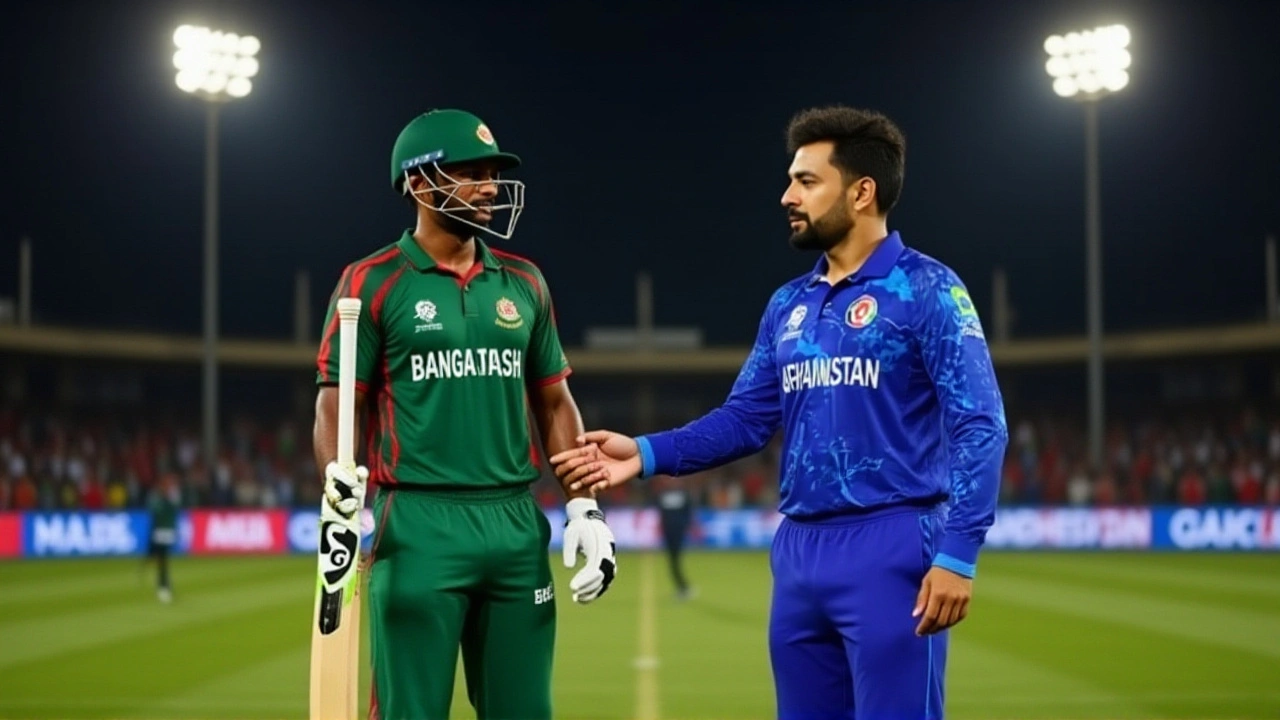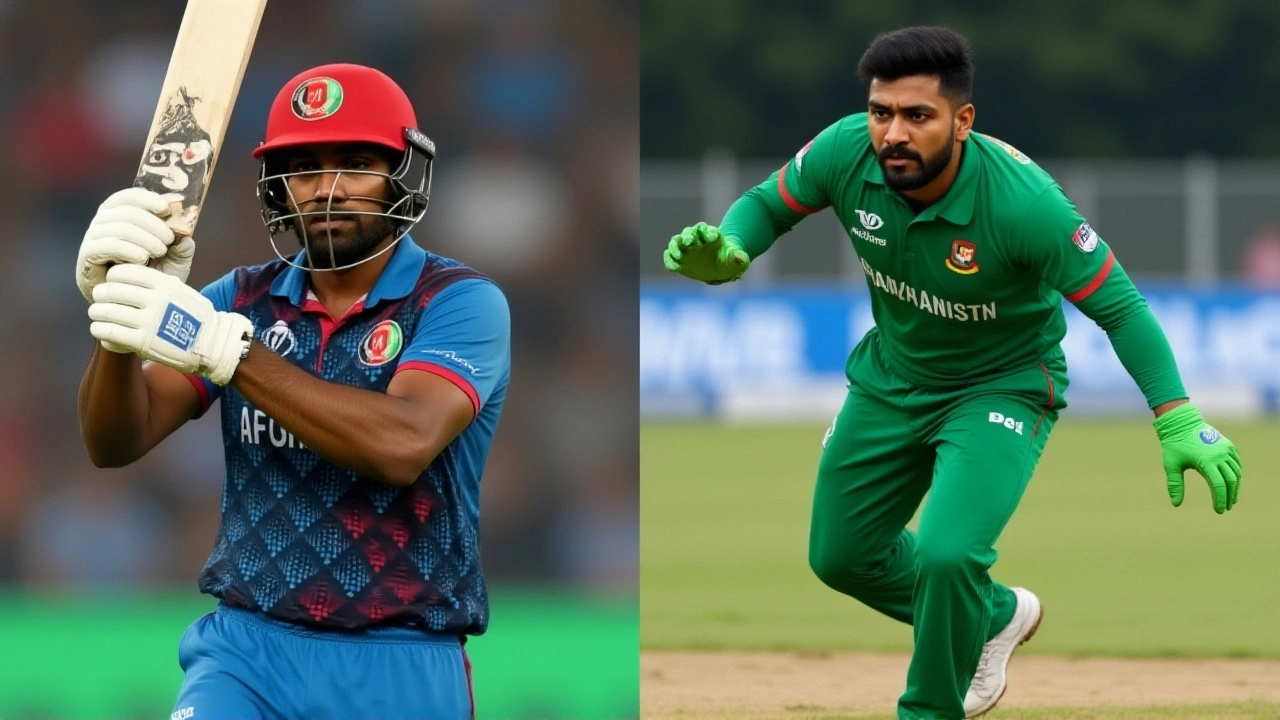Afghanistan Leads 2‑0 as Saif Hassan Debuts in UAE ODI Series

When Saif Hassan, batsman for Bangladesh cricket team, stepped onto the crease on October 8, 2025, the Etisalat Cup ODI series in the United Arab Emirates took on a new level of intrigue. The match was the opening encounter of a three‑game One Day International (ODI) showdown between Bangladesh and Afghanistan, a series confirmed earlier that summer by the Afghanistan Cricket Board. Afghanistan, riding high after back‑to‑back series wins over Bangladesh in 2023 and 2024, were eager to cement their dominance on neutral ground.
Background to the Tour
Bangladesh’s October 2025 tour of the UAE was part of a broader strategy to play more neutral‑venue cricket, allowing both sides to avoid logistical headaches in war‑torn Afghanistan. The Afghanistan side, led by captain Hashmatullah Shahidi, had already announced a packed itinerary that included three ODIs and three Twenty20 Internationals. Historically, Afghanistan has held a winning edge in recent head‑to‑head match‑ups – they clinched the series in 2023 by 2‑1 and repeated the feat in 2024. The Etisalat Cup, sponsored by the regional telecom giant, promised lucrative prize money and a chance for emerging talent to shine.
Match‑by‑Match Recap
First ODI – October 8, 2025
Bangladesh won the toss and elected to bat. They posted 221 for 7 in 48.5 overs, with Mehidy Hasan Miraz top‑scoring at 60 off 87 balls. Bangladesh’s bowlers made a decent dent, highlighted by Tanzim Hasan Sakib taking 3 for 31.
Afghanistan chased the target smoothly, reaching 226/5 in 47.1 overs. Rahmat Shah anchored the innings with a steady 50, while the ever‑reliable Rashid Khan claimed 3 for 38. The win gave Afghanistan a 1‑0 lead and marked Rashid’s 200th ODI wicket – a milestone he celebrated with a modest grin on the field.
Second ODI – October 11, 2025
Afghanistan turned the tables at the toss, opting to bat first. They were bowled out for 190 in 44.5 overs. The day’s star was Ibrahim Zadran, who struck 95 runs from 140 balls, falling just short of a century. Bangladesh’s response never found rhythm; Mehidy Hasan Miraz, who had shone with the bat in the first game, switched to the ball and nabbed 3 for 42. Afghanistan secured an 81‑run victory, extending the series lead to 2‑0.
Third ODI – October 12, 2025 (Scheduled)
With the series already decided, the final match is set for a midday start at 12:00 PM local time. Both teams will likely use the game to test fringe players ahead of the upcoming T20I leg. Expect Afghanistan to aim for a clean sweep, while Bangladesh may give Saif Hassan a longer run in the middle order.
Player Debuts and Milestones
The opening fixture was a double‑debut day. Bangladesh handed Saif Hassan his first ODI cap, while Afghanistan introduced Bashir Ahmad to the senior level. Saif, 22, entered the arena under a cloud of expectation after solid domestic performances for Dhaka Division. He contributed a quick‑fire 30 before being dismissed, giving him a modest start on the world stage.
Rashid Khan’s 200th wicket came midway through Bangladesh’s innings, a delivery that clipped the off‑stump of opening batsman. “It’s a personal landmark, but the team’s win matters more,” Rashid said in a post‑match interview.

Reactions from Teams and Analysts
Afghanistan’s coach, Jonathan Trott, praised his side’s composure: “Playing in the UAE can be tricky because of the lights and the pitch, but the boys showed why they’re the favourites.” Bangladesh’s captain, Nasum Ahmed, was more measured. “We had moments of brilliance, especially from Miraz, but we need to finish games stronger,” he noted.
Cricket analyst Harsha Bhogle highlighted the strategic angle: “Afghanistan’s spin‑heavy attack, led by Rashid, is proving fatal on sub‑continental surfaces, even in the UAE’s slower pitches.” He added that Bangladesh’s route back to parity hinges on developing a more aggressive top‑order and tighter death‑over bowling.
What the Series Means for Future Encounters
Afghanistan’s 2‑0 lead not only secures the Etisalat Cup but also boosts their world‑ranking points, edging them closer to a direct World Cup qualification spot. For Bangladesh, the series serves as a reality check ahead of the 2026 ICC Cricket World Cup qualifiers, where they will face tougher opposition.
Both boards have hinted at using the remaining ODIs to experiment with squad depth. Bangladesh’s coaches are expected to give Saif Hassan a longer spell, while Afghanistan may rotate bowlers to keep Rashid fresh for the upcoming T20I series.

Upcoming Schedule and What’s Next
- October 12, 2025 – 3rd ODI (UAE, 12:00 PM)
- October 15–16, 2025 – Two T20Is (UAE, night matches)
- October 20, 2025 – Final T20I (UAE)
After the T20I leg, both nations will return home for domestic seasons, but the lessons learned in the desert will echo into the next ICC cycle. Fans can expect Rashid Khan to continue chasing his next wicket milestone, while Saif Hassan hopes to turn his debut nerves into a steady international career.
Frequently Asked Questions
How does Rashid Khan’s 200th ODI wicket impact Afghanistan’s chances in the series?
Reaching 200 wickets underscores Rashid’s consistency and gives Afghanistan a psychological edge. His ability to break partnerships early often swings matches in Afghanistan’s favor, as seen in the first ODI where his three wickets helped limit Bangladesh to 221.
What opportunities does Saif Hassan have after his debut?
Saif’s 30‑run knock gave the selectors a glimpse of his temperament under pressure. If he builds on this foundation in the second and third ODIs, he could cement a middle‑order spot and become a regular feature in Bangladesh’s limited‑overs plans.
Why were the matches played in the United Arab Emirates?
Both teams lack suitable home venues for international cricket—Afghanistan due to security concerns and Bangladesh looking to avoid monsoon‑affected conditions. The UAE offers world‑class facilities and neutral ground, ensuring no home‑advantage skew.
What does the 2‑0 series lead mean for Bangladesh’s World Cup qualification hopes?
The loss adds pressure on Bangladesh in the upcoming qualification windows. They’ll need to win future series against higher‑ranked sides to accumulate enough points, making the remaining ODIs and T20Is crucial for rebuilding confidence.
When is the final ODI scheduled and what can fans expect?
The third ODI is set for October 12, 2025, at 12:00 PM local time in the UAE. With Afghanistan already leading 2‑0, the match is likely to be a showcase for squad depth, giving emerging players a chance to prove themselves before the T20I leg.
20 Comments
Apurva Pandya
It's disheartening to see Afghanistan cruising past Bangladesh while the latter still pretends they're on equal footing; fairness in sport demands that every team earn its wins, not coast on home‑ground comforts :)
Nishtha Sood
Bangladesh showed resilience in the first two games, and there's plenty of room for Saif Hassan to grow into his role. Keep believing, the young lads can turn this around.
Hiren Patel
When the desert heat of the UAE kisses the cricketing turf, something electric stirs in every player's soul; the saga of Afghanistan versus Bangladesh is no ordinary contest. Saif Hassan's debut, though modest, painted a vivid picture of raw potential. The crowd's roar echoed like a storm, shaking the very foundations of the pavilion. Rashid Khan's 200th wicket stood as a towering monument to perseverance, each spin ball a whisper of destiny. Meanwhile, Mehidy Hasan Miraz's all‑round display reminded us that heroes are forged in adversity. The pitch, a fickle beast, offered both bounce and turn, testing every batsman's mettle. Afghanistan's aggressive chase painted a tableau of confidence, each run a brushstroke of dominance. Bangladesh's bowlers, though valiant, occasionally faltered, slipping into complacency like a sinking ship. Yet the game’s narrative is far from over; the third ODI looms like an unwritten chapter. Young Saif could erupt like a phoenix, his future innings brimming with promise. The strategic maneuvers by coaches linger in the shadows, shaping what will be a battle of wits. Fans across the subcontinent hold their breath, hoping for a turnaround that could redefine the series. Each delivery, each catch carries weight, as if the very fate of nations rests upon them. The spin‑heavy onslaught from Rashid is a lesson in humility for any batting side. Bangladesh must adapt, innovate, and perhaps unleash a hidden arsenal of aggression. In the end, cricket is a beautiful paradox-its simplicity hides profound complexity, and this series embodies that very truth.
Heena Shaikh
One might argue that the pursuit of victory is merely a superficial construct, yet Afghanistan's relentless onslaught proves that will trumps technique. The essence of sport lies in dominance, and any dissenting whisper about fairness is merely noise.
Chandra Soni
Let's leverage the current momentum and synergize our batting strategies to optimize run conversion rates; by calibrating strike rotation and employing high‑impact partnerships, Bangladesh can recalibrate its performance matrix and close the competitive gap.
anil antony
Honestly, all that buzzword salad doesn't change the fact that Bangladesh looks like they're playing with a broken bat; effort over hype, any day.
Aditi Jain
While you prattle on about effort, the reality is that Afghanistan's cricketing pedigree eclipses any so‑called 'effort' from Bangladesh, a truth that should humble you.
arun great
From a coaching perspective, it’s crucial to analyse the spin dynamics and adjust the batting stance accordingly 😊. Proper footwork against Rashid’s deliveries can dramatically improve run‑scoring opportunities.
Anirban Chakraborty
It's evident that sportsmanship is being compromised when teams rely on home advantage rather than earning their victories.
Krishna Saikia
Friendly reminder: Afghanistan's track record shows they earned each win on merit, not by exploiting conditions, so let’s give credit where it’s due.
Meenal Khanchandani
True greatness comes from hard work, not shortcuts.
Anurag Kumar
Analyzing the bowlers' line lengths reveals opportunities for batsmen to exploit gaps; a focused approach on targeting those zones could shift the momentum.
Prashant Jain
Your analysis is shallow; the data clearly shows Bangladesh's inability to adapt.
DN Kiri (Gajen) Phangcho
We all can learn from each other and grow together this series is a chance to lift each other up and push beyond limits
Yash Kumar
But maybe the hype around Rashid is overblown he still gets wickets because opponents are weak yet he could struggle against top order batsmen if conditions change
Aishwarya R
The scoreboard tells a story of dominance that cannot be ignored.
Vaidehi Sharma
Wow that was a bold statement 😮
Jenisha Patel
While it is commendable, the prevailing sentiment, which has been echoed throughout numerous analyses, suggests that strategic adjustments-particularly in field placements, bowler rotations, and batting order flexibility-are imperative for Bangladesh to bridge the performance gap.
Ria Dewan
Ah, the ever‑so‑wise pundits, preaching what they already know while the players chase shadows on the sand.
rishabh agarwal
Perhaps the truth lies somewhere between the noise and the nuance, waiting for a calm mind to discern.


Write a comment